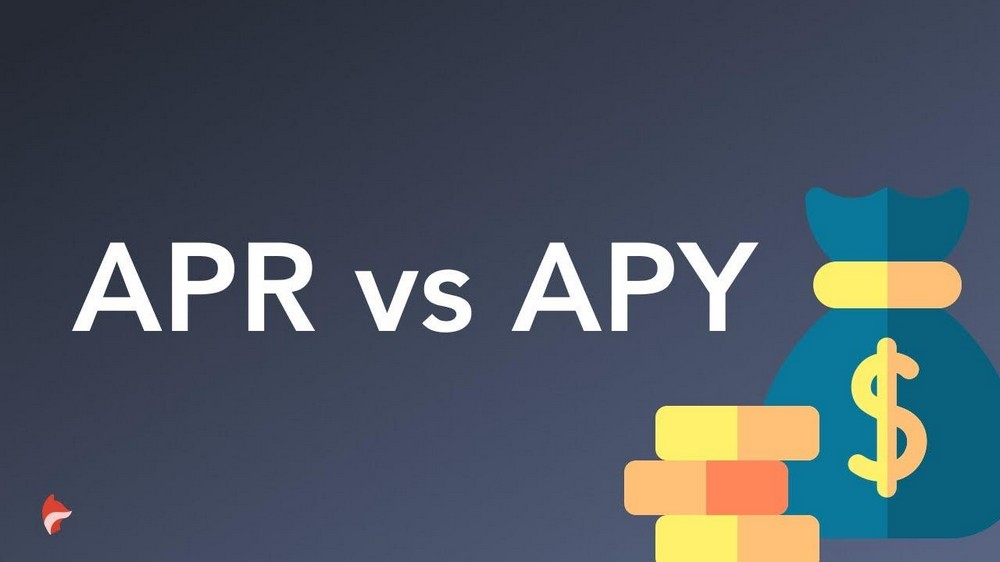 Strategies of hedging: definition, benefits and risks for traiders
Strategies of hedging: definition, benefits and risks for traidersCryptocurrencies primarily owe their explosive popularity to such a great invention as staking. Staking allows people to make pretty good cash with little to no effort. Working similarly to regular savings accounts, staking still offers considerably higher returns than traditional banks do.If you want to jump on this bandwagon and earn a few dollars on crypto staking, you should have a grasp of APY crypto meaning, i.e., the extra you will gain on your initial deposit.
What is APY?
APY is an acronym for Annual Percentage Yield, and it reflects the amount of compound interest to be given to you on top of your initial investment. Compound interest consists of returns gained from your initial investment, plus the returns gained from these returns. In simple words, APY in crypto is the annual return gained from the initial deposit plus accumulated interest.APY is traditionally associated with regular banks, yet many blockchain-enabled decentralized finance (DeFi) platforms employ it too. In DeFi, APY is generally offered through staking, savings accounts, and yield farming via liquidity pools.APY can be earned through cryptocurrency exchanges and DeFi protocols, though many advanced crypto wallets also come with in-built APY products, such as MetaMask and Exodus, which provide an array of interest-bearing tools.The earned interest is commonly paid in the same cryptocurrency as the one in which the initial deposit was opened. Sometimes, APY is paid in a different cryptocurrency than the underlying principal – it depends on the specifics of a given DeFi platform or the investment asset itself.
What Is Special About APY?
Savings accounts in traditional finance usually offer both SIR (simple interest rate) and APY (annual percentage yield).- APY means the annual gains earned from the principal (the initially deposited sum) combined with the accrued interest on that principal.
- SIR means the interest earned from the initial deposit, without factoring in the accumulated returns. For example, if a user deposits $1,000 USD with a regular bank, and the offered SIR is 7%, in a year, the user will have $1,070 USD on their account balance.
How is APY Different from APR?
When exploring DeFi projects, it is typical to encounter financial products that offer either APY (annual percentage yield) or APR (annual percentage rate). At first glance, the two look identical as both options allow for earning interest on your crypto possessions. Frequently, both terms are used interchangeably.
Still, APY and APR are two different earning modes.
How Does APY Work in Crypto?
In the cryptocurrency space, APY allows users to earn compounding interest on their crypto possessions. APY can be earned through crypto savings accounts, staking, yield farming, or by contributing liquidity to liquidity pools.Again, annual percentage yield is what you will earn on your single investment over the specified period (one full year).
 Suppose you open a savings account with some reputable DeFi platform and deposit 100 Bitcoin at a 5% APY. A year later, you will have 105 Bitcoin in your deposit balance, minus a small fee that the DeFi platform of your choice will charge for its service. So, you may ultimately expect to receive a slightly smaller sum than 105 Bitcoin once the deposit period expires.It is important to remember that APY implies an annualized return. The projected 5% in our example will be credited to you only after one full year passes. However, gains are often credited to you monthly. In this case, the entire APY rate is broken down from its annual rate.
Suppose you open a savings account with some reputable DeFi platform and deposit 100 Bitcoin at a 5% APY. A year later, you will have 105 Bitcoin in your deposit balance, minus a small fee that the DeFi platform of your choice will charge for its service. So, you may ultimately expect to receive a slightly smaller sum than 105 Bitcoin once the deposit period expires.It is important to remember that APY implies an annualized return. The projected 5% in our example will be credited to you only after one full year passes. However, gains are often credited to you monthly. In this case, the entire APY rate is broken down from its annual rate.How to Calculate APY?
The easiest way to calculate APY-based rewards is to multiply the initial deposit’s amount by the APY value.For example, your DeFi platform offers a 15% APY on USDT savings accounts.You want to deposit 1000 USDT. How much will you finally earn?Let’s calculate it:1000 × 15% = 150.
In a year, your 1000 USDT savings account will bring you additional 150 USDT, and you will eventually have 1150 USDT on your balance. If you want to know how much your investment will bring you on a monthly basis, you need to divide the projected annual return by the number of months. For example, you already know that your 1000 USDT savings account will generate 150 USDT over one year. To calculate the monthly APY, you need to divide 150 by 12 (the amount of months within one year):
If you want to know how much your investment will bring you on a monthly basis, you need to divide the projected annual return by the number of months. For example, you already know that your 1000 USDT savings account will generate 150 USDT over one year. To calculate the monthly APY, you need to divide 150 by 12 (the amount of months within one year):(1000 × 15%)/12 = 12.5
So, your 1000 USDT will bring you an extra 12.5 USDT every month.To calculate your weekly APY rewards, you need to divide the projected monthly APY by the amount of weeks in one month (4 weeks). This is how it looks:(1000 × 15%)/12/4 = 3.125
Every week, you will get an extra 3.125 USDT on your 1000 USDT savings account with a 15% APY.The DeFi platform of your selection will always provide a handy APY calculator, so you will quickly know how much you will gain over a certain period.If you choose to withdraw your digital funds after a week of holding, you will receive only 3.125 above your original sum, and you will not reap the benefits of a compounding effect of APY. However, if you keep your funds for a year, the APY interest will be added to your balance weekly, and the returns paid on your undated balance will increase throughout the year.Pay attention to compounding terms when engaging in a particular interest-bearing activity. Some instances may guarantee daily, weekly, and monthly compounding, while others pay only annual compounding rewards.
Why is APY in Crypto Higher Than in Regular Banking?
Traditional financial institutions tend to have miserable APYs ranging from 0.1% up to 5-7% annual percentage yield. In contrast, APY in crypto is frequently surprisingly higher up to 20-30%, and individual DeFi platforms can even offer a three-figure APY on some of their crypto products. How comes it?The cryptocurrency economy is still in its infancy, and the decentralized nature of many DeFi companies allows them to deliver financial services omitting centralized intermediaries. So, DeFi platforms can establish more lucrative APY rewards because they do not need to share their revenue with banks and other centralized authorities.The market landscape and high volatility also drive APY in crypto upwards. The APY rate will be higher for better-performing cryptocurrencies with huge capitalization, while sluggish, unpopular cryptocurrencies prone to have a lower APY.Another driving force behind high APY in crypto is borrowing. Loans in high-demand cryptocurrencies may come with a higher APR compared to loans in less popular coins. So APYs on lending in highly-sought-after cryptocurrencies will expectedly be elevated.Sometimes, a high APY can be established for certain cryptocurrencies for promotion purposes.
How comes it?The cryptocurrency economy is still in its infancy, and the decentralized nature of many DeFi companies allows them to deliver financial services omitting centralized intermediaries. So, DeFi platforms can establish more lucrative APY rewards because they do not need to share their revenue with banks and other centralized authorities.The market landscape and high volatility also drive APY in crypto upwards. The APY rate will be higher for better-performing cryptocurrencies with huge capitalization, while sluggish, unpopular cryptocurrencies prone to have a lower APY.Another driving force behind high APY in crypto is borrowing. Loans in high-demand cryptocurrencies may come with a higher APR compared to loans in less popular coins. So APYs on lending in highly-sought-after cryptocurrencies will expectedly be elevated.Sometimes, a high APY can be established for certain cryptocurrencies for promotion purposes.What Are the Risks of Using High APY in Crypto?
It may be tempting to engage in an activity that promises significant returns on investment. APYs of 100% per cent are hard to resist. Here are some pitfalls to be aware of before getting into crypto activities with elevated APY:- Lack of insurance. The immediate risk to consider is that many DeFi platforms still fail to provide adequate protections for their customers in worst-case scenarios. If a DeFi platform shuts down, customers may lose all their deposits and the accumulated interest because, unlike traditional banks, DeFi institutions do not offer federal deposit insurance programs.
- Rules on withdrawals. If you keep a regular savings account, you can withdraw your funds and close your account at any time. However, this cannot work for a staking or deposit position with a high APY. In the crypto world, claiming your assets back before the due date may not be immediate, but it can take a few weeks to proceed. During this pending period, your assets will be out of your control, yet will not generate any gains on them. Along with not getting the projected APY, you will also need to pay a high fee in most cases for withdrawing your money out of a sudden.
- Volatility. High APY is commonly set for highly-fluctuating assets. The original principal and gains will change according to market conditions. If the price of the asset drops, a high APY will only indicate greater losses.
Bottom Line
APY stands for Annual Percentage Yield, and it is actively utilized both in the traditional finance and cryptocurrency space. APY is a return on investment that factors in compounded interest. Higher APYs are very desirable for investors, yet you should take your time to research the project you are going to invest in to ensure it is not risky or a scam. Ever-changing market conditions should also be considered when starting any interest-bearing activity.Comments
Subscribe
Login
0 Comments







